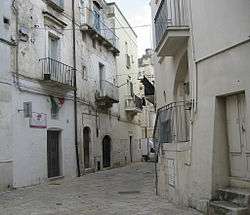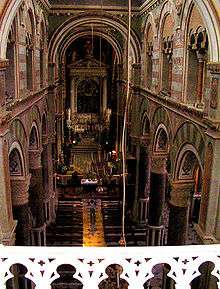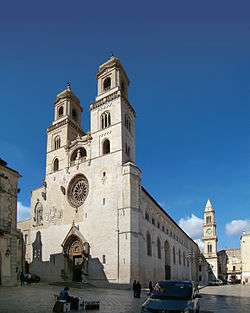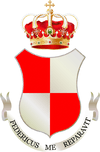Altamura
| Altamura | ||
|---|---|---|
| Comune | ||
| Comune di Altamura | ||
|
| ||
| ||
.svg.png) Altamura within the Province of Bari | ||
 Altamura Location of Altamura in Italy | ||
| Coordinates: 40°49′N 16°33′E / 40.817°N 16.550°E | ||
| Country | Italy | |
| Region |
| |
| Province / Metropolitan city | Bari (BA) | |
| Frazioni | Casal Sabini, Fornello, Madonna del Buon Cammino, Marinella, Masseria Franchini, Pescariello, Sanuca | |
| Government | ||
| • Mayor | Mario Antonio Felice Stacca | |
| Area | ||
| • Total | 427 km2 (165 sq mi) | |
| Elevation | 450 m (1,480 ft) | |
| Population (October 2012)[1] | ||
| • Total | 69,738 | |
| • Density | 160/km2 (420/sq mi) | |
| Demonym(s) | Altamurani | |
| Time zone | CET (UTC+1) | |
| • Summer (DST) | CEST (UTC+2) | |
| Postal code | 70022 | |
| Dialing code | 080 | |
| Patron saint | Sant'Irene | |
| Saint day | May 5 | |
| Website | Official website | |


Altamura [ˌaltaˈmuːra] is a city and comune of Apulia, in southern Italy. It is located on one of a hill of the Murge plateau in the province of Bari, 45 kilometres (28 miles) southwest of Bari, close to the border with Basilicata. As of 2011 its population was 70,288.[2]
The city is known for its particular quality of bread called Pane di Altamura, which is sold in numerous other Italian cities. According to the Latin poet Horace: "...for water is sold here, though the worst in the world; but their bread is exceeding fine, inasmuch that the weary traveler is used to carry it willingly on his shoulders."[3]
The 130,000-year-old calcified Altamura Man was discovered in the nearby limestone cave called the grotta di Lamalunga.
History

The area of modern Altamura was densely settled in the Bronze Age (La Croce settlement and necropolis).
The ancient city was known as Altilia, from Alter Ilium, the "other Troy". According to a legend, it was founded by a friend of Aeneas, Antellus, also a fugitive from the Asian city destroyed by the Greeks. Another legend attributes the foundation to Althea, queen of the Myrmidons.
The region contains some fifty tumuli. Between the 6th and the 3rd century BCE a massive line of megalithic walls was erected. From the following century, however, the importance of the city decayed. It recovered some importance when the Emperor Frederick II refounded the city and ordered the construction of the large Altamura Cathedral in 1232, which became one of the most venerated sanctuaries in Apulia. In 1248, under pressure from Frederick, Pope Innocent IV declared Altamura exempt from the jurisdiction of the bishop of Bari, making it a "palatine church", that is the equivalent of a palace chapel.
Altamura was ruled by various feudal families, including the Orsini del Balzo and the Farnese (1538–1734), the latter responsible of the construction of numerous palaces and churches. In 1748 Charles VII of Naples had a University built in the city.
In 1799 the city rebelled against the Bourbon government: the revolt, however, was suppressed two days later and the city sacked by Fabrizio Ruffo's troops. During the Risorgimento (19th century), Altamura was the seat of the Insurrection Bari Committee and, after the unification, the provisional capital of Apulia.
Geography
The city is located in the south-west area of the Province of Bari, near the borders with the Province of Matera, in Basilicata. The bordering municipalities are Bitonto, Cassano delle Murge, Gravina in Puglia, Grumo Appula, Matera, Ruvo di Puglia, Santeramo in Colle and Toritto.
Some 12,660 hectares (31,300 acres) of the communal territory are included in the Alta Murgia National Park.
Main sights
Altamura's main landmark is the Romanesque cathedral, begun in 1232 by Frederick II and restored in 1330 and 1521–47. It is one of the four Palatine churches of Apulia, the others being the cathedral of Acquaviva delle Fonti, the Basilica of San Nicola in Bari and the church of Monte Sant'Angelo sul Gargano. The construction is influenced by that of Bari, but also with strong Gothic influences typical of the time of Frederick II. The orientation of the construction was probably changed during the 14th century restoration, to which also belongs the northern portal opening on the square; a second bell tower, the altar area and the sacristy are instead from the 16th century. Externally, the main features are the rose window, with 15 small columns radially intermingling, and the Gothic portal, set into the entrance portico standing on two stone lions. On the arch of portals are sculpted 22 panels with scenes from Jesus' life. The interior, with a nave and two aisles, has stone presepe by Altobello Persio (1587).
The medieval walls for which the city has its name, erected by Frederick II, rest upon the megalithic walls of an ancient city of unknown name. These early walls are of rough blocks of stone without mortar.
Ancient tombs with fragments of vases and terracottas have also been found, of which there is a collection at the Museo Archeologico Statale di Altamura. There are caves which have been used as primitive tombs or dwellings, and a group of some fifty tumuli near Altamura.
Footprints of dinosaurs have been recently discovered.
Economy
Banca Popolare di Puglia e Basilicata, a cooperative bank of southern Italy, is based in Altamura. The bank is a successor of Banca Popolare di Altamura, founded in 1888.
Transport
The city is crossed by the SS7 "Via Appia" national road.
Altamura railway station, owned both by the national company FS and by FAL, is located on the regional lines Rocchetta Sant'Antonio-Altamura-Gioia del Colle (FS), Bari-Altamura-Matera (FAL) and Altamura-Avigliano-Potenza (FAL). Also the municipal localities of Casal Sabini, Marinella and Pescariello have their own stations. The one of Sanuca was closed in the late 1990s.
Twin towns — Sister cities
Altamura is twinned with:
-
 Lucera, Italy
Lucera, Italy -
 Modica, Italy
Modica, Italy -
 Castellana Sicula, Italy
Castellana Sicula, Italy
People
- Giovanni Antonio Del Balzo Orsini (1386 or 1393–1463), prince of Taranto
- Giacomo Tritto (1733–1824), composer
- Giuseppe Ciccimarra (1790–1836), opera singer
- Saverio Mercadante (1795–1870), opera composer
- Domenico Tranaso (1796-1854), notary
- Giacomo Bellacchi (1838–1924), mathematician
- Giuseppe Oronzo Giannuzzi (1838–76), physiologist
- Nicola Serena di Lapigio (1875–1938), writer and journalist
- Donato Squicciarini (1927–2006), Catholic archibishop
- Romeo Sacchetti (b. 1953), former basketball player
- Francesco Caputo (b. 1987), football player
- Mary Valastro Pinto (née Tubito), former employee of Carlo's Bake Shop and character of the TLC network program Cake Boss[4]
Military
The 31st tank regiment of the Italian Army is stationed at Altamura.
References
External links
| Wikimedia Commons has media related to Altamura. |
- Official website (Italian)
- Richard Stillwell, ed. Princeton Encyclopedia of Classical Sites, 1976: "Altamura, Apulia, Italy"
- "The Altamura prehistorical man"
- Museo Archeologico Statale di Altamura (Italian)
- Catholic Encyclopedia: "Altamura and Aquaviva"
- Encyclopaedia Britannica 1911: "Altamura"
- Altamura bread, discussion and photos

